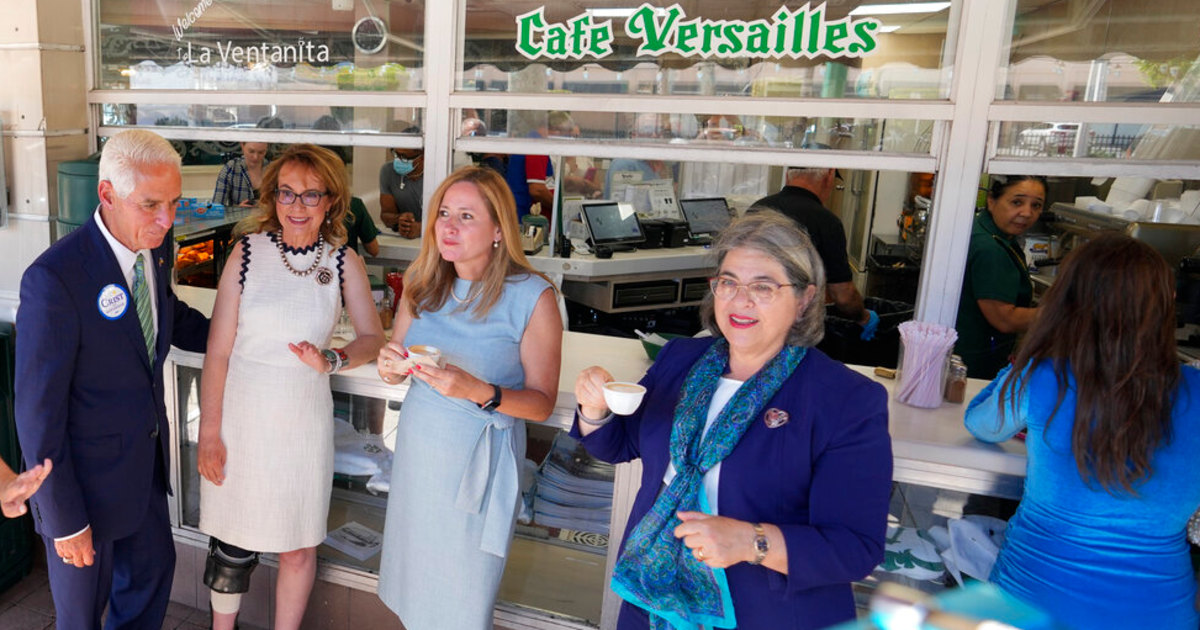Welcome to Axios Latino, a newsletter to tell you every Tuesday and Thursday the stories that have a special impact on the Latino communities in the United States and in Latin America. If you are interested in subscribing and receiving the newsletter in your email (
in English
), you can do so
by clicking here
.
You will always find it in Spanish on Noticias Telemundo.
1 theme to highlight: Itinerant art that names numbers
Art exhibitions
seek to reformulate the narrative around people who migrate and the reasons for their trip to the United States by engaging visitors with their stories.
Why It Matters
: The interactive and traveling exhibits attempt to humanize the hemisphere's migrants at a time when a record number of people have died trying to cross the border.
During fiscal year 2021, which ended in September, the Border Patrol recorded 557 deaths at the southern border, the highest number since records exist and 50% higher than in 2020.
Details
: One exhibition,
Ruta Norte
at the Ciudad Juárez Museum, uses virtual reality to immerse visitors in a border shelter while listening to the recorded stories of people who have traveled a migrant journey through the Americas.
Another traveling exhibit,
Hostile Terrain 94
, references a 1994 Border Patrol policy of "prevention through deterrence," which sought to make crossings near urban centers or formal entry points more difficult.
As a result, people attempt the journey through an inhospitable desert, where temperatures are dangerously high;
by mountainous areas, or by the river, where drownings are frequent (its name in Spanish, Rio Bravo, refers to the fierce currents).
How it works
: The centerpiece of
Hostile Terrain 94
is more than 3,200 forensic tags of people who died between 2001 and 2020, representing both bodies found along the border that have been identified and bodies that have not.
Exhibition labels Hostile Terrain 94 Museum of Us
After a short workshop at the beginning, visitors are encouraged to fill in the labels with the information available on each deceased person: their name, where they were from, the reasons why they left their country, where they were found and in what state.
"It is the same information from the official databases, but we present it in a different way so that it connects with the public" and they reflect on the similarities they could have with the deceased, said Jason de León, UCLA anthropologist and director of the Undocumented Migration Project, a non-profit artistic and educational collective behind the exhibition.
In his own words
:
"When you write [the labels], everything becomes very real. & Nbsp; With every detail you understand why these people left their countries & nbsp; and ended up dying of heat stroke, hypothermia, exhaustion, dehydration and many other terrible things."
Luis Valdez, visitor to the Hostile Terrain exhibition at the Museo de Nosotros in San Diego.
2.
Malcolm X's Latino Connections
New information shows that Latinos
helped shape Malcolm X's experiences and education, although the historic activist rarely spoke about Hispanics during his time as a civil rights advocate.
Malcolm X during an outdoor speech Bob Parent / Hulton Archive / Getty Images
Details
: Malcolm X's mother, Louise Little, was born on the island of Grenada in the West Indies and was fluent in Spanish.
The activist's family later lived in Omaha, Nebraska, Milwaukee, Wisconsin, and Lansing, Michigan, areas with a strong presence of migrant and Mexican farm workers.
According
to Les Payne and Tamara Payne's
2021 Pulitzer Prize-winning biography
The Dead Are Arising: The Life of Malcolm X
, a young Malcolm learned from Mexican migrants in Lansing how to grow better marijuana.
He sold cannabis for income.
The Big Picture
: Malcolm X was instrumental in shaping the narrative about the struggle of non-white people in America and the legacy of discrimination they endured.
However, Latinos are often excluded from that story.
Malcolm X himself at some point suggested that Afro-Latinos did not live the same as black people in the US, stating that "Puerto Ricans were not enslaved and the racial problem comes from imposing slavery."
However, Puerto Rico, as a former Spanish colony, was part of the slavery system both to transport people by force to the United States and to Caribbean plantations.
Influence
: Activists from the Chicano Movement and Puerto Rican Young Lords adopted some of Malcolm X's philosophies on anti-colonialism and self-determination.
Chicano leaders José Angel Gutiérrez, Rodolfo Gonzales, and Reies Lopez Tijerina gave speeches influenced by Malcolm X with language that suited the Latino audience.
Context
: During the time of Malcolm X, most of the country (outside of the southwestern United States) knew very little about the discrimination faced by Mexican-Americans and other Latinos.
3.
Honduras votes for a change
Leftist Xiomara Castro
has a strong lead after Sunday's elections in Honduras and is close to becoming the first president of the impoverished and troubled Central American country.
Xiomara Castro expands the lead that she hopes to make her the first president of Honduras
Nov. 29, 202101: 58
Why it matters
: Honduras faces rising unemployment and a shrinking economy, along with an increase in violence and long-standing crime, with officials accused of rampant corruption and having close ties to drug traffickers.
Living under such instability and lack of governance has forced many more people to leave their homes and emigrate, mainly to Mexico, the United States and Spain.
The effects of climate change, such as increasing drought and harsher hurricane seasons, have also fueled migration in recent years.
Between the lines
: If their advantage is maintained, Castro and his Free Party will break a 12-year term of the National Party, which according to US prosecutors fostered a "narco-state."
Castro thus faces the popular expectation of straightening the ship of a nation that has been in crisis practically since 2009, when her husband, then-President Manuel Zelaya, was overthrown in a coup due to a disagreement with Congress.
The new Congress, also elected on Sunday, is not yet defined.
It could thwart Castro's program, self-proclaimed "feminist, anti-patriarchal, revolutionary and inclusive";
Congressmen will also determine the next attorney general and the composition of the new supreme court.
To be on the lookout:
Current President Juan Orlando Hernández has been embroiled in allegations of voter fraud since the 2017 vote and could face the US justice system after he leaves office in January.
Hernández was named a co-conspirator in court documents when his brother was sentenced for drug trafficking in March, so he could face extradition if he is formally charged.
4. A mystery with climatic consequences
Deep in the jungle
near the Mexico-Guatemala border is a mangrove forest that, in theory, shouldn't be there.
Its existence contains clues as to what climate change could mean for sea levels.
Mysterious mangroves in Mexico give clues about what the sea level will be in the future
Oct. 29, 202102: 46
Details
: The forest is about 105 miles (170 kilometers) inland, on a freshwater river.
Mangroves normally exist and thrive in coastal areas with salt water.
Why it matters
: Tests in the area found that seawater levels were up to 29 feet (9 meters) higher due to melting glaciers tens of thousands of years ago, and that is why the trees settled there saline.
This data suggests that, with current global warming trends, the world could return to those seawater levels.
According to estimates, 800 million people live less than 16 feet (5 meters) above current sea level.
The intrigue
: Studies found that the forest originated around 125,000 years ago in the ice age, and over time the trees adapted to the lack of salt by absorbing calcium from nearby limestone deposits.
Along with the red mangroves, around 100 species from its surrounding ecosystem also adapted to fresh water.
"Studying these adaptations will be very important to better understand future conditions in a changing climate," says Octavio Aburto Oropeza, lead author of the analysis and a marine ecologist at the Scripps Institution of Oceanography at UC San Diego.
5.
Summary of key news in Latin America and the Caribbean
Hunger and poor nutrition in Latin America and the Caribbean
have reached their highest figures since 2000, warns a report by UNICEF, the WHO and the Food and Agriculture Organization of the United Nations.
Hunger increased 30% in the region during the first year of the pandemic, when four out of 10 people were unable to get the meals they needed.
In the United States, one in five Latinos had to skip meals in the past year, according to the Department of Agriculture.
A Brazilian woman scavenges through the garbage of a street market in search of food.Raimundo Pacco / AFP via Getty Images
Chile is close to legalizing same-sex marriage
, pending only a final Senate vote on a proposal that would also allow LGBTQ couples to adopt.
It would join Argentina, Brazil, Colombia, Costa Rica, Ecuador, Uruguay, and a handful of Mexican states in officially recognizing the rights of same-sex couples.
The proposal even has the backing of the socially conservative president Sebastián Piñera, and could be approved before the second round of the presidential elections on December 19 changes political priorities.
6. 🎓 Farewell smile: senior graduates
Age is just a number
for two older Mexican adults who recently graduated from college in a country where few adults typically do.
This 93-year-old Mexican fulfills her dream of having a career in business administration
Nov. 26, 202103: 55
Details
: Felipe Espinosa, 85, and María Josefina Cruz, 93, were unable to continue their studies during their youth due to their financial situation, but they say they had been yearning to return to classes.
Cruz returned to school when one of his granddaughters started college and graduated in October from Business Administration after decades of working at store counters and in a bank.
Espinosa turned to farming and selling fruit when he was a teenager, and he kept working on it to take his own children to school.
When they finished and he retired, he decided to study Process Engineering and Industrial Management.
He graduated in May.
38% of illiterate people in Mexico are seniors, and only 2 out of 10 Mexican adults have university studies, one of the lowest percentages among OECD countries.
In his own words
: "It is never too late to get out of ignorance or ignorance," Cruz told Noticias Telemundo.
Thanks for reading us
.
We returned on Thursday
.
Do you want to see any of the most recent previous editions?
Mute voices and books
The Latino story of Thanksgiving
The purchasing power of Latinas
Serve, and live as a veteran, being Hispanic
The fight for 'green' money
A tradition in transition









